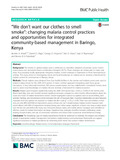| dc.description.abstract | BACKGROUND:
The decline in global malaria cases is attributed to intensified utilization of primary vector control interventions and artemisinin-based combination therapies (ACTs). These strategies are inadequate in many rural areas, thus adopting locally appropriate integrated malaria control strategies is imperative in these heterogeneous settings. This study aimed at investigating trends and local knowledge on malaria and to develop a framework for malaria control for communities in Baringo, Kenya.
METHODS:
Clinical malaria cases obtained from four health facilities in the riverine and lowland zones were used to analyse malaria trends for the 2005-2014 period. A mixed method approach integrating eight focus group discussions, 12 key informant interviews, 300 survey questionnaires and two stakeholders' consultative forums were used to assess local knowledge on malaria risk and develop a framework for malaria reduction.
RESULTS:
Malaria cases increased significantly during the 2005-2014 period (tau = 0.352; p < 0.001) in the riverine zone. March, April, May, June and October showed significant increases compared to other months. Misconceptions about the cause and mode of malaria transmission existed. Gender-segregated outdoor occupation such as social drinking, farm activities, herding, and circumcision events increased the risk of mosquito bites. A positive relationship occurred between education level and opinion on exposure to malaria risk after dusk (χ2 = 2.70, p < 0.05). There was over-reliance on bed nets, yet only 68% (204/300) of respondents owned at least one net. Complementary malaria control measures were under-utilized, with 90% of respondents denying having used either sprays, repellents or burnt cow dung or plant leaves over the last one year before the study was conducted. Baraza, radios, and mobile phone messages were identified as effective media for malaria information exchange. Supplementary strategies identified included unblocking canals, clearing Prosopis bushes, and use of community volunteers and school clubs to promote social behaviour change.
CONCLUSIONS:
The knowledge gap on malaria transmission should be addressed to minimize the impacts and enhance uptake of appropriate malaria management mechanisms. Implementing community-based framework can support significant reductions in malaria prevalence by minimizing both indoor and outdoor malaria transmissions. | en_US |



